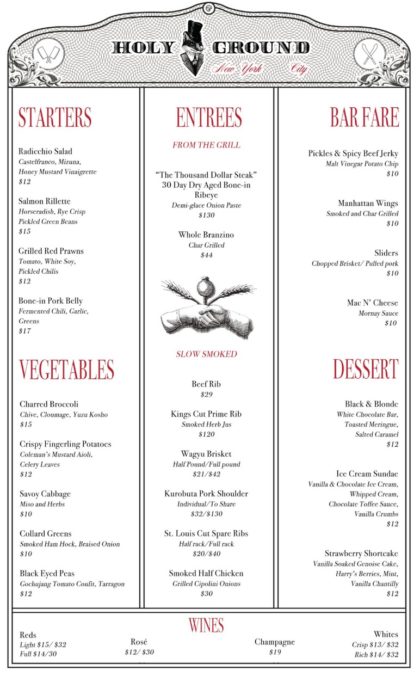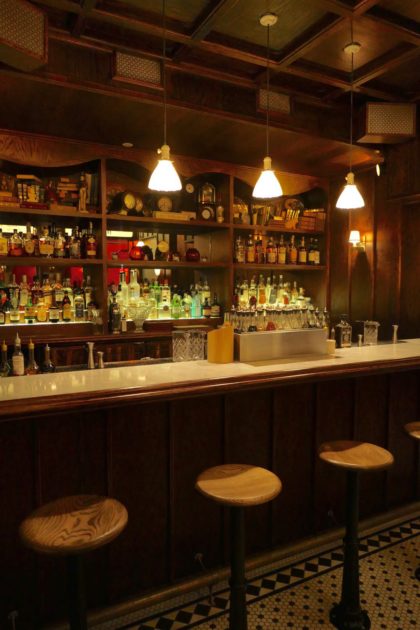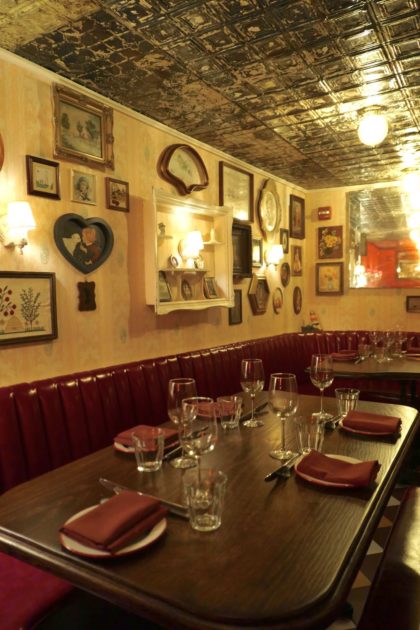Categories
Left column house ads
New Kid on the Block: Holy Ground
July 30, 2018 Restaurant/Bar News

 While A Summer Day Café evokes an afternoon at the seaside, its half-sibling downstairs, Holy Ground, is more of a night in the big city. “We were inspired by classic New York City establishments like the 21 Club and Keens,” says restaurateur Matt Abramcyk. He’s partnering on Holy Ground with Nathan Lithgow and Franco V, who had been cooking barbecue at Fort Gansevoort gallery in the Meatpacking District and a pop-up in Williamsburg. As with other Abramcyk restaurants, such as Tiny’s and Smith & Mills, there’s a strong sense of place: “We want you to feel transported to an earlier part of the city’s history.” The feeling is dark and clubby, with wood everywhere, a flea market’s worth of knick-knacks and art, maroon leather banquettes, red damask wallpaper, and, in a booth for two tucked under the stairs, a collage of erotica.
While A Summer Day Café evokes an afternoon at the seaside, its half-sibling downstairs, Holy Ground, is more of a night in the big city. “We were inspired by classic New York City establishments like the 21 Club and Keens,” says restaurateur Matt Abramcyk. He’s partnering on Holy Ground with Nathan Lithgow and Franco V, who had been cooking barbecue at Fort Gansevoort gallery in the Meatpacking District and a pop-up in Williamsburg. As with other Abramcyk restaurants, such as Tiny’s and Smith & Mills, there’s a strong sense of place: “We want you to feel transported to an earlier part of the city’s history.” The feeling is dark and clubby, with wood everywhere, a flea market’s worth of knick-knacks and art, maroon leather banquettes, red damask wallpaper, and, in a booth for two tucked under the stairs, a collage of erotica.
As for the food, the idea is to augment barbecue and steakhouse classics with contemporary touches, such a smoked savoy cabbage with miso or black-eye peas with gochujang tomato confit and tarragon. The cocktail program is by Matt Hunter, formerly of Eleven Madison Park, and brunch service is expected to start in the fall.
Holy Ground is at 112 Reade (at W. Broadway); 646-882-0666; holygroundnyc.com.





 Recent New Kid on the Block / First Impressions articles:
Recent New Kid on the Block / First Impressions articles:
• Interlude Coffee & Tea
• Manhatta
• Glam+Go
• A Summer Day Café
• Seamore’s
• Gitano
• Allied Maker
• Trader Joe’s
4 Comments
Comment:
Subscribe
Subscribe to the TC Newsletter













The interior design look is great, but there are just too many reasons to stop eating meat. Ordering a big steak is something akin to driving a monster SUV – vulgar, at the very least, but maybe something more, something worse.
Agreed. Future generations (if there are any after what we’re doing to our world) may look on such currently culturally “normal” behavior with horror.
Wow. This is opinionated commentary. Can’t remember meat eaters harshing on vegetarians in this way.
“The 2006 report Livestock’s Long Shadow, released by the Food and Agriculture Organization (FAO) of the United Nations, states that ‘the livestock sector is a major stressor on many ecosystems and on the planet as a whole. Globally it is one of the largest sources of greenhouse gases (GHG) and one of the leading causal factors in the loss of biodiversity, while in developed and emerging countries it is perhaps the leading source of water pollution.’
Removing all U.S. agricultural animals would reduce U.S. greenhouse gas emissions by 2.6%.”
https://en.wikipedia.org/wiki/Environmental_impact_of_meat_production